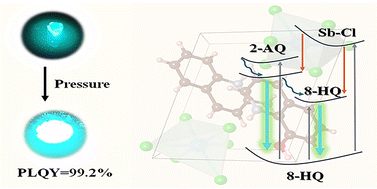Antimony halides have gained significant interest owing to their demonstrated potential in photoluminescence, laser, display and photovoltaic applications. Herein, for the first time, we report a series of 1D hybrid organic–inorganic perovskites with a novel structure, i.e., (2-AQ)x(8-HQ)1−xSbCl4 (2-AQ = 2-aminoquinoline; 8-HQ = 8-hydroxyquinoline; 0 ≤ x ≤ 0.109), and the regulation of the π–π conjugated aggregated state for a tuneable emission property. In particular, under the orbit coupling of p–π orbits and hydrogen bond-assisted charge transport, excitons effectively recombined from organic components and the metal octahedron [SbCl6]3− to 8-HQ, producing efficient green light emissions. Interestingly, upon application of pressure to single crystals, the (2-AQ)0.9(8-HQ)0.1SbCl4 perovskite showed slight lattice expansion/shrinkage, by which the inefficient transfer and recombination process of π*–π* from 2-AQ to 8-HQ were suppressed and replaced by the efficient transfer and recombination process of p–π* from [SbCl6]3− to 8-HQ. The target material exhibited smaller effective electron mass, which is beneficial for charge transfer and high emission efficiency. Accordingly, (2-AQ)0.9(8-HQ)0.1SbCl4, with the lowest photon energy loss and blue light emission, realized an ultra-high PLQY value of 99.2% through short-term high-pressure treatment.
